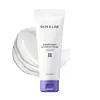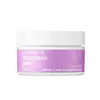What's inside
What's inside
 Key Ingredients
Key Ingredients

No key ingredients
 Benefits
Benefits

 Concerns
Concerns

 Ingredients Side-by-side
Ingredients Side-by-side

Water
Skin ConditioningGlycerin
HumectantButylene Glycol
HumectantCetyl Ethylhexanoate
EmollientCyclopentasiloxane
EmollientHydrogenated Poly(C6-14 Olefin)
EmollientPentaerythrityl Tetraethylhexanoate
EmollientDimethicone
EmollientSqualane
Emollient1,2-Hexanediol
Skin ConditioningPolyglyceryl-3 Methylglucose Distearate
EmulsifyingPentylene Glycol
Skin ConditioningGlyceryl Stearate
EmollientHydrogenated Vegetable Oil
EmollientPanthenol
Skin ConditioningStearyl Alcohol
EmollientArachidyl Alcohol
EmollientCetyl Alcohol
EmollientCetearyl Alcohol
EmollientPolymethylsilsesquioxane
Behenyl Alcohol
EmollientHydroxyethyl Acrylate/Sodium Acryloyldimethyl Taurate Copolymer
Emulsion StabilisingMannitol
HumectantGlyceryl Arachidonate
EmollientGlyceryl Linoleate
EmollientGlyceryl Linolenate
EmollientArachidyl Glucoside
EmulsifyingCopernicia Cerifera Wax
Cetearyl Glucoside
EmulsifyingEthylhexylglycerin
Skin ConditioningDipotassium Glycyrrhizate
HumectantHydrogenated Olive Oil Lauryl Esters
Emulsion StabilisingSerine
MaskingXanthan Gum
EmulsifyingGlycine
BufferingLecithin
EmollientSodium Phytate
Arginine
MaskingWater, Glycerin, Butylene Glycol, Cetyl Ethylhexanoate, Cyclopentasiloxane, Hydrogenated Poly(C6-14 Olefin), Pentaerythrityl Tetraethylhexanoate, Dimethicone, Squalane, 1,2-Hexanediol, Polyglyceryl-3 Methylglucose Distearate, Pentylene Glycol, Glyceryl Stearate, Hydrogenated Vegetable Oil, Panthenol, Stearyl Alcohol, Arachidyl Alcohol, Cetyl Alcohol, Cetearyl Alcohol, Polymethylsilsesquioxane, Behenyl Alcohol, Hydroxyethyl Acrylate/Sodium Acryloyldimethyl Taurate Copolymer, Mannitol, Glyceryl Arachidonate, Glyceryl Linoleate, Glyceryl Linolenate, Arachidyl Glucoside, Copernicia Cerifera Wax, Cetearyl Glucoside, Ethylhexylglycerin, Dipotassium Glycyrrhizate, Hydrogenated Olive Oil Lauryl Esters, Serine, Xanthan Gum, Glycine, Lecithin, Sodium Phytate, Arginine
Water
Skin ConditioningDipropylene Glycol
HumectantGlycerin
HumectantMethyl Trimethicone
Skin ConditioningCetearyl Alcohol
EmollientUndecane
EmollientBehenyl Alcohol
EmollientTriolein
Skin Conditioning1,2-Hexanediol
Skin ConditioningButyrospermum Parkii Butter
Skin ConditioningTridecane
PerfumingCetearyl Olivate
Dipentaerythrityl Hexahydroxystearate/Hexastearate/Hexarosinate
Skin ConditioningSorbitan Olivate
EmulsifyingEclipta Prostrata Leaf Extract
Skin ConditioningLaminaria Japonica Extract
Skin ProtectingGlyceryl Dioleate
EmollientPalmitic Acid
EmollientStearic Acid
CleansingHydrogenated Lecithin
EmulsifyingCetearyl Glucoside
EmulsifyingButylene Glycol
HumectantAmmonium Acryloyldimethyltaurate/Vp Copolymer
Glyceryl Stearate Se
EmulsifyingCentella Asiatica Extract
CleansingFicus Carica Fruit Extract
HumectantCeramide NP
Skin ConditioningEclipta Prostrata Extract
Skin ConditioningC12-15 Alkyl Benzoate
AntimicrobialMelia Azadirachta Leaf Extract
Skin ConditioningCholesterol
EmollientXanthan Gum
EmulsifyingMelia Azadirachta Flower Extract
Skin ConditioningFructooligosaccharides
HumectantCoccinia Indica Fruit Extract
Skin ConditioningBeta-Glucan
Skin ConditioningDisodium EDTA
Amaranthus Caudatus Seed Extract
Skin ConditioningUlmus Davidiana Root Extract
Skin ConditioningAloe Barbadensis Flower Extract
EmollientSolanum Melongena Fruit Extract
Skin ConditioningHydrolyzed Hyaluronic Acid
HumectantMyristic Acid
CleansingMoringa Oleifera Seed Oil
EmollientOcimum Sanctum Leaf Extract
Skin ConditioningGlycine
BufferingTocopherol
AntioxidantCorallina Officinalis Extract
Skin ConditioningCurcuma Longa Root Extract
MaskingSerine
MaskingGlutamic Acid
HumectantGuaiazulene
AntimicrobialAspartic Acid
MaskingLeucine
Skin ConditioningAlanine
MaskingLysine
Skin ConditioningArginine
MaskingTyrosine
MaskingPhenylalanine
MaskingProline
Skin ConditioningThreonine
Valine
MaskingIsoleucine
Skin ConditioningHelianthus Annuus Seed Oil
EmollientHistidine
HumectantCysteine
AntioxidantMethionine
Skin ConditioningWater, Dipropylene Glycol, Glycerin, Methyl Trimethicone, Cetearyl Alcohol, Undecane, Behenyl Alcohol, Triolein, 1,2-Hexanediol, Butyrospermum Parkii Butter, Tridecane, Cetearyl Olivate, Dipentaerythrityl Hexahydroxystearate/Hexastearate/Hexarosinate, Sorbitan Olivate, Eclipta Prostrata Leaf Extract, Laminaria Japonica Extract, Glyceryl Dioleate, Palmitic Acid, Stearic Acid, Hydrogenated Lecithin, Cetearyl Glucoside, Butylene Glycol, Ammonium Acryloyldimethyltaurate/Vp Copolymer, Glyceryl Stearate Se, Centella Asiatica Extract, Ficus Carica Fruit Extract, Ceramide NP, Eclipta Prostrata Extract, C12-15 Alkyl Benzoate, Melia Azadirachta Leaf Extract, Cholesterol, Xanthan Gum, Melia Azadirachta Flower Extract, Fructooligosaccharides, Coccinia Indica Fruit Extract, Beta-Glucan, Disodium EDTA, Amaranthus Caudatus Seed Extract, Ulmus Davidiana Root Extract, Aloe Barbadensis Flower Extract, Solanum Melongena Fruit Extract, Hydrolyzed Hyaluronic Acid, Myristic Acid, Moringa Oleifera Seed Oil, Ocimum Sanctum Leaf Extract, Glycine, Tocopherol, Corallina Officinalis Extract, Curcuma Longa Root Extract, Serine, Glutamic Acid, Guaiazulene, Aspartic Acid, Leucine, Alanine, Lysine, Arginine, Tyrosine, Phenylalanine, Proline, Threonine, Valine, Isoleucine, Helianthus Annuus Seed Oil, Histidine, Cysteine, Methionine
Ingredients Explained
These ingredients are found in both products.
Ingredients higher up in an ingredient list are typically present in a larger amount.
1,2-Hexanediol is a synthetic liquid and another multi-functional powerhouse.
It is a:
- Humectant, drawing moisture into the skin
- Emollient, helping to soften skin
- Solvent, dispersing and stabilizing formulas
- Preservative booster, enhancing the antimicrobial activity of other preservatives
Arginine is an amino acid that is important for human development. Your body uses is it to produce hair keratin and skin collagen.
As a cosmetic ingredient, Arginine has antioxidant properties and can also help repair damaged skin. This ingredient is derived either synthetically or from animals.
Arginine isn't fungal acne safe when used in the presence of other lipids (fats, fatty acids, oils, esters, etc). Oils and fats occur naturally within the skin, so take caution when using Arginine if you're prone to fungal acne.
Learn more about ArginineBehenyl Alcohol is a type of fatty alcohol (these are different from the drying, solvent alcohols).
Fatty Alcohols have hydrating properties and are most often used as an emollient or to thicken a product. They are usually derived from natural fats and oils; behenyl alcohol is derived from the fats of vegetable oils.
Emollients help keep your skin soft and hydrated by creating a film that traps moisture in.
In 2000, Behenyl Alcohol was approved by the US as medicine to reduce the duration of cold sores.
Learn more about Behenyl AlcoholButylene Glycol (or BG) is used within cosmetic products for a few different reasons:
Overall, Butylene Glycol is a safe and well-rounded ingredient that works well with other ingredients.
Though this ingredient works well with most skin types, some people with sensitive skin may experience a reaction such as allergic rashes, closed comedones, or itchiness.
Learn more about Butylene GlycolCetearyl alcohol is a mixture of two fatty alcohols: cetyl alcohol and stearyl alcohol. It is mainly used as an emulsifier. Emulsifiers help prevent the separation of oils and products. Due to its composition, it can also be used to thicken a product or help create foam.
Cetearyl alcohol is an emollient. Emollients help soothe and hydrate the skin by trapping moisture.
Studies show Cetearyl alcohol is non-toxic and non-irritating. The FDA allows products labeled "alcohol-free" to have fatty alcohols.
This ingredient is usually derived from plant oils such as palm, vegetable, or coconut oils. There is debate on whether this ingredient will cause acne.
Due to the fatty acid base, this ingredient may not be Malassezia folliculitis safe.
Learn more about Cetearyl AlcoholCetearyl Glucoside is a surfactant and emulsifier. It can be produced from synthetic of natural sources of cetearyl alcohol and glucose.
Emulsifiers help prevent ingredients from separating, such as oils and waters. It can also be used to enhance the texture of products.
As a surfactant, Cetearyl Glucoside helps during the cleansing process. By gathering all the dirt and oils, it allows these molecules to be washed away easily.
Learn more about Cetearyl GlucosideGlycerin is already naturally found in your skin. It helps moisturize and protect your skin.
A study from 2016 found glycerin to be more effective as a humectant than AHAs and hyaluronic acid.
As a humectant, it helps the skin stay hydrated by pulling moisture to your skin. The low molecular weight of glycerin allows it to pull moisture into the deeper layers of your skin.
Hydrated skin improves your skin barrier; Your skin barrier helps protect against irritants and bacteria.
Glycerin has also been found to have antimicrobial and antiviral properties. Due to these properties, glycerin is often used in wound and burn treatments.
In cosmetics, glycerin is usually derived from plants such as soybean or palm. However, it can also be sourced from animals, such as tallow or animal fat.
This ingredient is organic, colorless, odorless, and non-toxic.
Glycerin is the name for this ingredient in American English. British English uses Glycerol/Glycerine.
Learn more about GlycerinThis ingredient is an amino acid that helps build proteins and moisturizes skin. It is already present in our skin as our bodies produce them naturally.
Glycine already plays a role in helping keep our skin moisturized as amino acids transport moisture throughout our skin.
As collagen is made up of glycine and other amino acids, it is believed glycine may help our skin produce more collagen.
Learn more about GlycineSerine is an amino acid naturally found in our body. Our bodies use amino acids to create protein.
Amino-acids help give keep our skin hydrated. They play an important role in the skin barrier, which keeps the skin plump and firm.
Serine is a non-essential amino acid, meaning we don't need to obtain it from eating foods.
Learn more about SerineWater. It's the most common cosmetic ingredient of all. You'll usually see it at the top of ingredient lists, meaning that it makes up the largest part of the product.
So why is it so popular? Water most often acts as a solvent - this means that it helps dissolve other ingredients into the formulation.
You'll also recognize water as that liquid we all need to stay alive. If you see this, drink a glass of water. Stay hydrated!
Learn more about WaterXanthan gum is used as a stabilizer and thickener within cosmetic products. It helps give products a sticky, thick feeling - preventing them from being too runny.
On the technical side of things, xanthan gum is a polysaccharide - a combination consisting of multiple sugar molecules bonded together.
Xanthan gum is a pretty common and great ingredient. It is a natural, non-toxic, non-irritating ingredient that is also commonly used in food products.
Learn more about Xanthan Gum